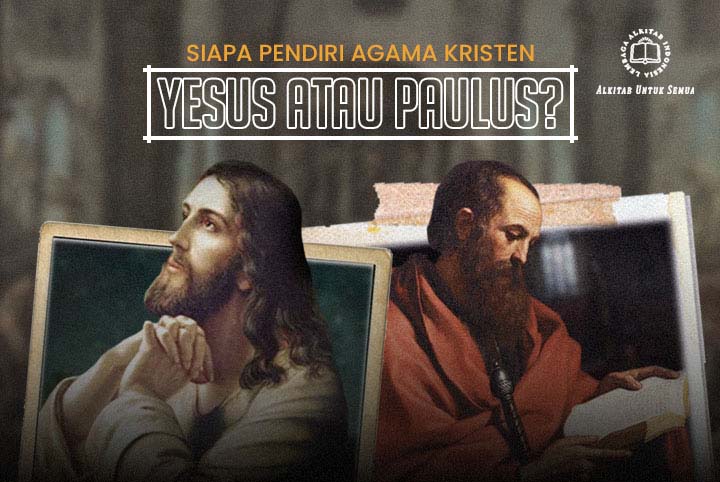1Peter 3:19; 4:6 | Hortensius F. Mandaru, SSL.
The topic of "preaching to the dead" has long been a subject of discussion and debate among theologians and Bible readers. The issue is not only exotic and full of mystery, but also involves the reading of relatively difficult texts, especially 1 Peter 3:19 and 4:6. In the Bible Talk of the Indonesian Bible Institute (LAI), Mr. Hortensius F. Mandaru, SSL, LAI Translation Supervisor, stated that this theme not only holds various interpretive possibilities, but also contains various theological contents that reflect the historical, exegetical, and communitarian contexts of the readers and interpreters.
The two main texts of concern are:
- 1 Peter 3:19. “and in the Spirit he went and preached to the spirits in prison”
- 1 Peter 4:6. “For this reason the gospel was preached also to the dead, that they, like all men, might be judged in the flesh, but might live by the Spirit according to the will of God.”
These two texts explicitly contain phrases about Christ "going" and "preaching" to spirits or the dead. The issue is complicated because the Bible does not provide a detailed linear narrative, and many terms such as "prison", "spirits", and "dead people" are open to various interpretations.
In Old Testament tradition, all the dead were believed to be gathered in שְׁאוֹל (sheol the world of the dead located at the very bottom of the earth, in accordance with the ancient view of a flat earth. In the early stages of Hebrew thought, Sheol did not distinguish between the righteous and the wicked; all souls ended up there without exception. Existence in sheol was not understood as true life. Existence there is vague and hazy, like shadows, so those who inhabit sheol are referred to as rephaim, i.e. weak and helpless beings. Life there is incomplete, as the spirits are unable to communicate visibly and effectively, either with God or with the living. In some biblical narratives, spirits can be summoned or resurrected, but they have no effective power to help, as illustrated in the story of Saul's summoning of Samuel's spirit. Samuel could speak, but not provide any real help.
In the early days, there was no understanding or expectation of resurrection, so faith in life after death did not develop. This is reflected, for example, in the attitude of the Sadducees who rejected the concept of resurrection, in accordance with their interpretation of the Torah. However, over time, especially after the exile, there were significant theological developments. The idea of a separation between the righteous and the wicked in sheol began to be recognized, as well as the expectation of resurrection, both collectively and individually. This thinking is clearly reflected in post-Torah texts, such as in the Book of 2 Maccabees.
Entering the New Testament tradition, the idea that Christ descended into the world of the dead began to develop. This idea appears in several important texts, such as Romans 10:6–7, Ephesians 4:8–9, Philippians 2:10, and Colossians 2:15, which imply that Christ has descended to the lowest part of the earth”. In a theological sense, this refers to Christ's act of defeating the power of death as well as freeing those who were "held captive" in the realm of death.
This act is not only interpreted as a victory over death, but also as Christ's participation in the most abject of human conditions, death itself, from which He fulfills His saving work.
This idea was later integrated in the Apostles' Creed. κατελθόνταεἰςτὰ κατώτατα, which means "He descended into the kingdom of death", or in the Latin phrase: descendit ad inferos, affirming the early church's belief that Christ's victory encompassed all of reality, including the realm of death and the underworld.
When did Jesus preach the gospel to the dead?
- Before the Incarnation: As Augustine and some modern interpreters propose, the pre-existent Christ already preached spiritually through figures such as Noah. Pre-incarnation.
- Between His Death and Resurrection: This is the traditional position that is consistent with the narrative order of 1 Peter 3, as well as with the Apostles' Creed. Jesus "descended" into the world of the dead between His death and resurrection. Although the Greek text only says "went away" (poreuomai). However, in the "flat earth" mindset, sheol/hades (the world of the dead) does exist beneath the earth. The lowest point! Other NT texts support the idea of Jesus "doing something" between His death and resurrection (cf. Acts 2:25; 13:35; Romans 10:7; Matthew 12:40).
- At Ascension and Glory: Christ proclaims the Gospel as part of His complete victory over all things in heaven, on earth, and under the earth.
Who is the target?
- All the dead in sheol or hades.
- The generation of Noah's day that perished because of disobedience (cf. Genesis 6; 2 Peter 2:5).
- Fallen angels (bene Elohim in Genesis 6) who are held until judgment, as also found in Jewish literature such as the Book of Enoch.
The phrase "spirits in prison" in 1 Peter 3:19 corresponds to the term used in the Book of Revelation for the world of the dead as a place of waiting. Contemporary commentaries favor the third option, that the spirits referred to are rebellious heavenly beings.
The meaning of preaching
In Greek, the verb used is ‘ἐκήρυξεν’ (ekēryxen, derived from ‘κηρύσσω’ (kēryssō)), which means "to proclaim, to announce". Although the word gospel or εὐαγγέλιον (euangelion is not explicitly mentioned, in the context of 1 Peter which emphasizes Christ's suffering as a victory over the powers of evil, the proclamation is interpreted as the proclamation of the gospel in the form of a declaration of divine victory.
To the creature resisted (the powers of evil), it is judgment; to the believer, it is the glad tidings of deliverance and victory. Thus, LAI's translation choice of "preach the gospel" has a strong basis in theological semantics. In the context of the recipients of the letter of 1 Peter, who were living under oppression and persecution, the idea that Christ had defeated the power of death and proclaimed His victory even to the world of the dead, provided strength and comfort. Christ is not only the victor over the upper world, but also the lower world. He is the Lord of all creation, including those hidden in the "dark prison".
“There is not a single force and power that can separate us from the care and protection of Christ. All the suffering and persecution that the church experiences, will surely end and be overcome by Christ, the Victor. The enemies will be punished, the faithful will be restored, and continue to live.”

























